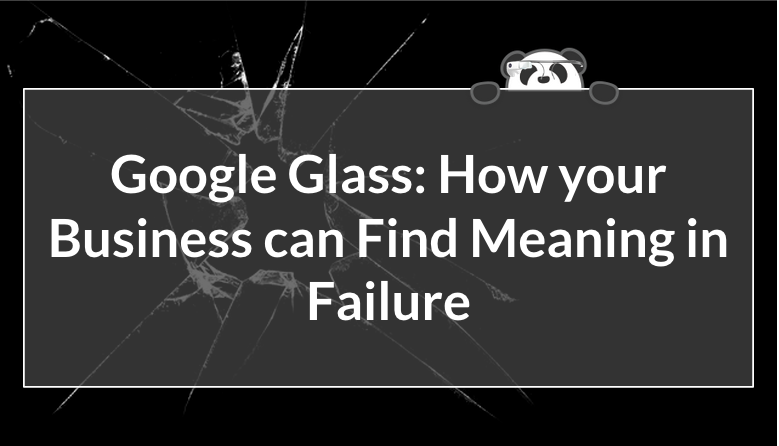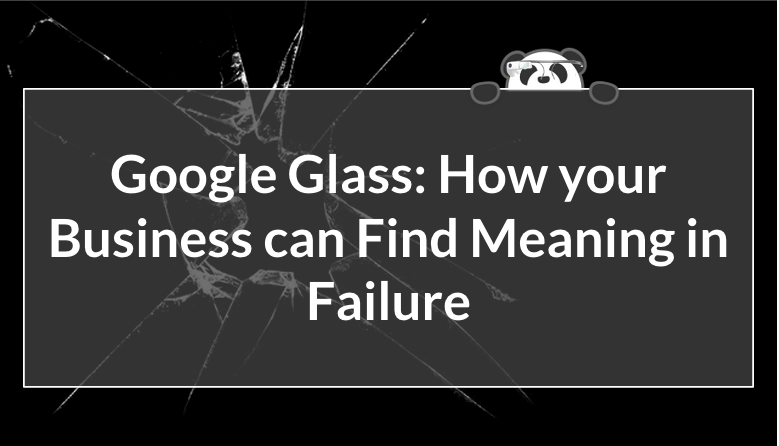
This Monday (January 19, 2015) was the last day that Google Glass (Version 1.0) was available for public sale. They’ve failed in wearable face technology, at least for now…
At a whopping $1,500 a pop, the futuristic – though ultimately unappealing – design and the constant questions (“are you recording me???”) leave little question as to why they failed. And it’s not the first timethey have.
Yet despite these failures, if you said the word “Google” to anyone, there is not a single possibility their first thought would be “Failure.”
This is because Google has not, and will not, let failures like Google Glass stop them. Staying on the cutting edge of innovative technology has made it so that when they produce a debacle like Google Glass, it’s old news after a week or two.
What I’m trying to get at here – in a roundabout way – is to show you how embracing failure the right way can be good for your business.
But how does this work?
How can you fail the right way?
I’m going to share with you how Google has responded (quite successfully) to stopping production on Google Glass, and what you can learn from their failure.
Learning from your mistakes
Rather than seeing a failure from far away and running in the other direction, you need to be analyzing what went wrong, what you can learn from it and how you can change it in the future.
It’s not simply saying, “I messed up, let’s not do it again,” it should be, “It happened, now what can we do to improve this system, this technology or this error so it doesn’t happen the same way.”
It’s the “oh shit” moment after we pressed send on a huge mailout before checking that everything was going right. (Sorry, blog subscribers!)
True, Google is pulling their first version of Google Glass off the market but they’re not giving up. Instead of having the heart monitor flatten out, they’re taking a different approach to develop the product further. They’re putting it back on the operating table and figuring out how they’re going to make it work to keep it alive.
Google has pulled Glass back into the development stage to see how they can address the current technology and make it appropriate for the general public.
Only time will tell how Google learn from the early failures of Glass but by no means do I see this as the end.
Avoid pointing fingers
Playing the blame game is not only not going to solve your problem, but it will likely annoy the person most capable of solving it.
Blame has a negative connotation and rightly so. It’s been historically used as a way to encourage people to constructively respond to their failures, but how often has this worked in practice?
Making people feel guilty for taking the risks they take, albeit in Google’s case a bit edgy for the 2012-14 time frame, isn’t going to accomplish much.
Google Glass’ former head, Ivy Ross, wasn’t blamed for developing an ultimately failed product. Rather, she is being put on the next development stage under the supervision of Tony Fadell, to keep taking those risks and pushing those limits.
If this says anything about Google, it’s that they’re okay with taking risks. Without risks you’ll never find the hole in your market; the marketing campaign that hits home; the product that nobody’s thought of; or the success that Google has.
What Google said about backing out
Ross said that they’re already working on the next version of Google Glass but that it’ll only be released when it’s ready. In short, they arguably learned more from the failure of Google Glass (that the market isn’t ready for it), than they would have from its success.
Rephrased perfectly by Martha Pease, “Just because you can build something doesn’t mean you should.” The world isn’t always ready for a new product or service. Google Glass was a beta test, gone too public too fast.
Not to mention the perception of people who wear Google Glasses as ‘Glassholes.’
One of the key executives on the Google Glass team, Sebastian Thurn, was shocked by how people responded to the design of Google Glass. He had no idea that people would find the Google Glass design undesirable.
This is of little surprise seeing that the majority of early testers were located in the Silicon Valley, a place full of early adopters and, arguably, future “Glassholes” themselves. In the next round of production Google needs to investigate how they can make the product useable for the rest of society instead of simply looking at what is appropriate inside the bubble of Silicon Valley.
Failure is not going to keep them from trying again, and it shouldn’t stop you.
In Conclusion
Be passionate about what you do. This is as cliche a phrase as they come. Yet being passionate about what you do will give you the energy and motivation to keep your business fresh and exciting, especially after a failure.
Always keep an optimistic attitude about your failures. Yes, there will be a lot of them. But it’s in those failures that you’ll see your greatest successes.
Google Glass tried to do something and for the first time in a long time, they failed, badly. Though it remains awkward, Glass is already miles from where it was in 2011, when it was a scuba mask with a phone and cables attached to it. I’m excited to see where it goes in the future.
What are some failures you or your business have had and what have you learned from them? Please share your comments below, I’d love to hear from you.
– Written by Samantha Mykyte
When Samantha isn’t crushing content at Wishpond she performs with her burlesque troupe, casts spells in dungeons and dragons and enjoys baking and eating cookies.

